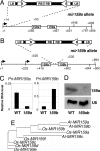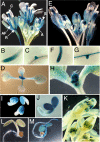Genetic analysis reveals functional redundancy and the major target genes of the Arabidopsis miR159 family
- PMID: 17916625
- PMCID: PMC2042213
- DOI: 10.1073/pnas.0707653104
Genetic analysis reveals functional redundancy and the major target genes of the Arabidopsis miR159 family
Abstract
Currently, there are very few loss-of-function mutations in micro-RNA genes. Here, we characterize two members of the Arabidopsis MIR159 family, miR159a and miR159b, that are predicted to regulate the expression of a family of seven transcription factors that includes the two redundant GAMYB-like genes, MYB33 and MYB65. Using transfer DNA (T-DNA) insertional mutants, we show that a mir159ab double mutant has pleiotropic morphological defects, including altered growth habit, curled leaves, small siliques, and small seeds. Neither mir159a nor mir159b single mutants displayed any of these traits, indicating functional redundancy. By using reporter-gene constructs, it appears that MIR159a and MIR159b are transcribed almost exclusively in the cells in which MYB33 is repressed, as had been previously determined by comparison of MYB33 and mMYB33 (an miR159-resistant allele of MYB33) expression patterns. Consistent with these overlapping transcriptional domains, MYB33 and MYB65 expression levels were elevated throughout mir159ab plants. By contrast, the other five GAMYB-like family members are transcribed predominantly in tissues where miR159a and miR159b are absent, and consequently their expression levels are not markedly elevated in mir159ab. Additionally, mMYB33 transgenic plants can phenocopy the mir159ab phenotype, suggesting that its phenotype is explained by deregulated expression of the redundant gene pair MYB33 and MYB65. This prediction was confirmed; the pleiotropic developmental defects of mir159ab are suppressed through the combined mutations of MYB33 and MYB65, demonstrating the narrow and specific target range of miR159a and miR159b.
Conflict of interest statement
The authors declare no conflict of interest.
Figures





References
Publication types
MeSH terms
Substances
LinkOut - more resources
Full Text Sources
Other Literature Sources
Molecular Biology Databases

